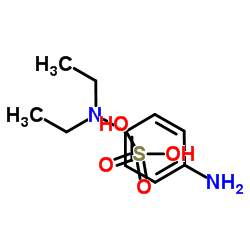N,N-Diethyl-1,4-benzenediamine sulfate (1:1)

N,N-Diethyl-1,4-benzenediamine sulfate (1:1) structure
|
Common Name | N,N-Diethyl-1,4-benzenediamine sulfate (1:1) | ||
|---|---|---|---|---|
| CAS Number | 6283-63-2 | Molecular Weight | 262.326 | |
| Density | N/A | Boiling Point | 274 - 275 | |
| Molecular Formula | C10H18N2O4S | Melting Point | 184-186 °C(lit.) | |
| MSDS | Chinese USA | Flash Point | N/A | |
| Symbol |

GHS07 |
Signal Word | Warning | |
|
Volatile disinfection by-product analysis from chlorinated indoor swimming pools.
Water Res. 43(13) , 3308-18, (2009) Chlorination of indoor swimming pools is practiced for disinfection and oxidation of reduced compounds that are introduced to water by swimmers. However, there is growing concern associated with formation for chlorinated disinfection by-products (DBPs) in the... |
|
|
Use of N, N-diethyl-p-phenylenediamine sulphate for the spectrophotometric determination of some phenolic and amine drugs.
Acta. Pharm. 60(2) , 217-27, (2010) Spectrophotometric methods are proposed for the determination of drugs containing a phenol group [salbutamol sulphate (SLB), ritodrine hydrochloride (RTD), isoxsuprine hydrochloride (IXP)] and drugs containing an aromatic amine group [dapsone hydrochloride (D... |
|
|
Differentiation of Salmonella typhi using resistotyping.
J. Appl. Bacteriol. 54(2) , 171-6, (1983)
|
|
|
Evaluation of chlorine dioxide gas residues on selected food produce.
J. Food Sci. 76(1) , T11-5, (2011) In recent years, the consumption of fresh fruits and vegetables has greatly increased, and so has its association with contamination of several foodborne pathogens (Listeria, Salmonella, and Escherichia coli). Hence, there is a need to investigate effective s... |
|
|
Measurement of the effect of a plant-based diet on reactive oxygen metabolite production using the d-Roms test is invalid.
Int. J. Biol. Markers 21(1) , 60; author reply 61-3, (2006)
|
|
|
[Hygienic basis for the maximum permissible concentrations of color developers in various types of bodies of water].
Gig. Sanit. (9) , 71-3, (1986)
|
|
|
Production, properties and application to biocatalysis of a novel extracellular alkaline phenol oxidase from the thermophilic fungus Scytalidium thermophilum.
Appl. Microbiol. Biotechnol. 71(6) , 853-62, (2006) Scytalidium thermophilum produces an extracellular phenol oxidase on glucose-containing medium. Certain phenolic acids, specifically gallic acid and tannic acid, induce the expression of the enzyme. Production at 45 degrees C in batch cultures is growth-assoc... |
|
|
Application of principal component-artificial neural network models for simultaneous determination of phenolic compounds by a kinetic spectrophotometric method.
J. Hazard. Mater. 157(1) , 161-9, (2008) A multicomponent analysis method based on principal component analysis-artificial neural network models (PC-ANN) is proposed for the determination of phenolic compounds. The method relies on the oxidative coupling of phenols (phenol, 2 chlorophenol, 3-chlorop... |
|
|
Comparison of colorimetric and membrane introduction mass spectrometry techniques for chloramine analysis.
Water Res. 41(14) , 3097-102, (2007) Three methods for the determination of chloramines in water were compared using pH-buffered nanopure water and natural organic matter (NOM) solutions. We investigated whether the N,N-diethyl-p-phenylenediamine (DPD) colorimetric method and/or an adapted indop... |
|
|
Effect of Cu(II) on the electrochemically initiated reaction of thiols with N, N-diethyl- p-phenylenediamine: methodology for the indirect voltammetric determination of Cu(II).
Anal. Bioanal. Chem 379(4) , 707-13, (2004) The effect of Cu(II) on the determination of homocysteine via its electrochemically initiated reaction with N, N-diethyl-p-phenylenediamine is examined. The presence of copper inhibited the detection process for homocysteine owing to a complexation reaction o... |